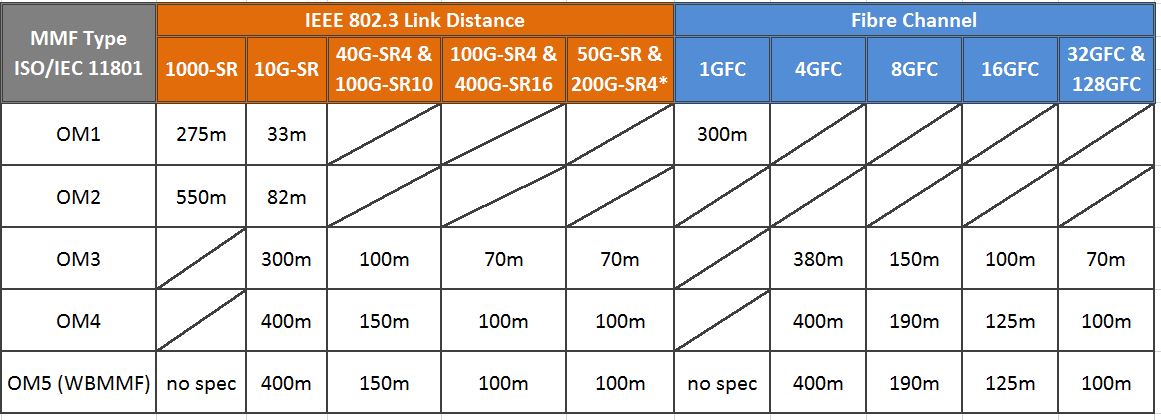Multimode Fiber Upgrades—When Are They Needed?
Should your fiber cable system be upgraded? We’ve been exploring the answer to this question in our last few blogs (talking about bending loss when reusing fiber cable here and reusing singlemode fiber here.
In this blog – the last in the series of three about fiber upgrades – we elaborate on the main multimode fiber standard specifications that have been developed to support new high-speed applications, and help you decide whether you need a multimode fiber upgrade or if your existing system will suffice.
Multimode Fiber Applications and Specifications
The original multimode fiber (MMF) standard, ANSI/TIA-492AAAA (OM1, 62.5/125 µm), was released in 1989 to support Fast Ethernet 100BASE-FX and 1000BASE-SX Ethernet, with a high numerical aperture (NA) of 0.275 and light capture from 1300 nm LED sources.
The ANSI/TIA-492AAAB standard for OM2 (50/125 µm) was released in 1998, with an improved modal bandwidth and a reduced NA of 0.2 to support higher data transmission, such as 1 Gbps VCSEL with longer reach.
To meet growing bandwidth requirements, laser-optimized multimode fiber (LOMMF) standards OM3 and OM4 were developed in 2002 and 2009, respectively, with effective modal bandwidths (EMBs) of 2000 MHz∙km and 4700 MHz∙km to support 10G, 40G and 100G Ethernet applications, as well as InfiniBand and the Fibre Channel protocols.
Historically, multimode optics operate with a single wavelength; MMF standards (OM1/OM2/OM3/OM4) have only specified the minimum bandwidth at 850 nm and 1300 nm (1300 nm LED is no longer used for the system speed at 10G or above). Recently, however, OM5 (wideband MMF) was developed and standardized in TIA and ISO/IEC organizations to support short wavelength division multiplexing (SWDM) from 840 nm to 953 nm.

MMF bandwidth and cable attenuation specifications
MMF Reach Limits
Although OM1 and OM2 MMF have been widely deployed in the past, they are no longer suitable for new Ethernet infrastructure deployment – mainly due to the intrinsic limited EMBs. Let’s take an up-close look at potential risks you may face when reusing legacy OM1 and OM2 fiber cables instead of completing a fiber upgrade.
OM1 (core diameter 62.5µm) has a different fiber geometry and can cause excessive signal loss, even at a short reach, when mating with newer MMF types (core diameter 50µm).
OM1 and OM2 can only support very limited reach for links above 1G, and can no longer support system speed upgrades. In the new ANSI/TIA-568.3-D standard, OM1 and OM2 MMF types are grandfathered in and aren’t recommended for new greenfield installation.
OM1 and OM2 have higher fiber cable attenuation (3.5 dB/km) compared to OM3, OM4 and OM5 (3.0dB/km); therefore, the appropriate link budget may not be met.
Currently, OM3 and OM4 are the most popular MMF types deployed in modern data centers; OM5 was just recently introduced to the market, so we’ll wait to see how long it takes for OM5 to be added to this list of popular MMF types.
OM3 MMF can support the latest Ethernet and Fibre Channel applications with reduced reach; however, cautions must be taken when mating legacy OM3 MMF with new bend-insensitive MMF (BI-MMF). The slight difference in fiber geometry could cause additional loss, negatively impacting cable performance.
OM4 BI-MMF is recommended for new fiber installation or fiber upgrade and replacement projects because the latest application standards are developed based on OM4 specifications.
OM5 is backward compatible with OM4, so it supports the equal reaches for the current applications. Its main differentiation is to support the transmission of multiple wavelengths over the single MMF thread. Paired with OM5, SWDM-based transceivers can considerably lower fiber cable and connectivity costs for point-to-point connections. SWDM standard specifications and products are currently in the development phase.

MMF types and supported link distances in IEEE 802.3 Ethernet and Fibre Channel applications
In some practical use cases, legacy fiber cable can be reused for new applications (depending on the fiber type) and fiber upgrades aren’t necessary, provided that the fiber capacity limitation is not a hurdle; however, this is not always true without fully understanding the link loss budget and transmission penalty.
When it comes to network speed upgrades, our recommendation is that you replace old OM1/OM2 or legacy OM3 with high-quality OM4 BI-MMF cabling to prevent light from escaping and causing bend-induced attenuation. This leads to better performance, higher bandwidth capabilities and improved optical performance. We also recommend taking a close look at OM5 if you plan to use SWDM-based transceivers in future fiber upgrades.
With this wise investment, your IT department can reduce total cost of ownership in the long run, with fewer maintenance hassles, easier troubleshooting and faster replacement. Fiber upgrades for old or legacy systems also ensures solid link performance and supports next-generation upgrade cycles.
